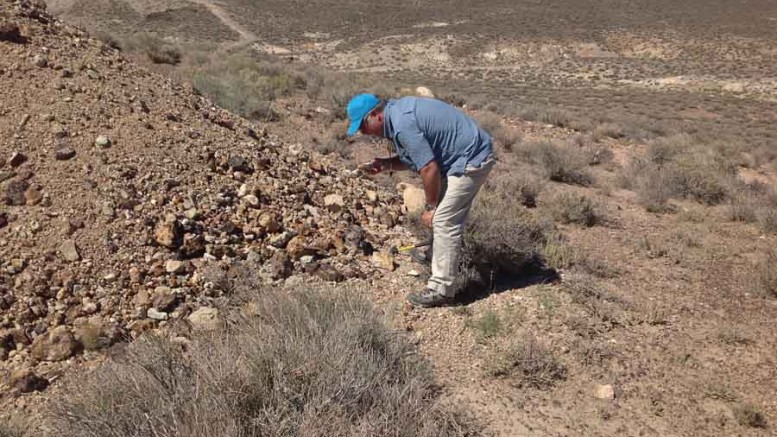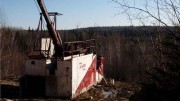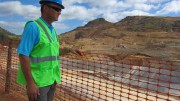CARSON CITY, NEVADA — Driving along a broad stretch of freeway on the outskirts of Reno, it is obvious that Altan Nevada’s (ANE-V) director of exploration Kelly Cluer calls Nevada home. He spent the first 10 years of his career here before work with Centerra Gold (CG-T) took him to the far reaches of the Mongolian steppes. Now back at home in Carson City, Cluer is ready to take principles he rediscovered during a decade away, and apply them to his old stomping grounds.
Vancouver-based gold explorer Altan Nevada has eight grassroots projects covering 174 sq. km across some of Nevada’s most prolific mining districts.
Altan president and CEO Evan Jones echoes Cluer about the company’s renewed interest in the Silver State: “We figured if you looked at Nevada a bit differently, there were lots of concepts and theories that really hadn’t been tested.”
Out of Altan’s eight projects, the company has staked seven, with the majority being greenfield prospects where Cluer plans on testing his new geological concepts.
The first stop on the tour is at Altan’s wholly owned Radar gold-silver property near the inactive Paradise Peak mine, which produced 1.6 million oz. gold and 22 million oz. silver from 1986 through 1994. The mill infrastructure still stands, and appears to be in good shape. Cluer explains that it remains on care and maintenance, with ownership hoping a new discovery will fuel a renaissance.
Radar lies at the end of rough stretch of road marked by the weathered remains of a small mercury mine, with an old, windowless wooden shack linked to two adits. The site had not been actively explored since the 1980s, despite being so close to Paradise Peak.
“Now, you do not see a lot of gold in some of these samples, but all of the trace elements are there: arsenic, mercury, as well as that little bit of gold,” Cluer explains after bashing off a piece of outcrop with his rock hammer. “But at a depth of roughly 300 metres the induced polarization (IP) numbers really get going. It’s a strong anomaly, and if you’re equating that chargeability to sulphide, it is really high. The geochemistry is definitely key here, we should be able to map some sort of zonation and come up with a story on this system when it is all said and done.”
Altan’s geochemical soil sampling and geophysical surveying in 2010 helped it identify drill targets within a structural fabric it believes may be similar to Paradise Peak.
Last March, Altan released results from its first phase of drilling at Radar, which includes four holes over 1,950 metres. The company aimed to test deep IP chargeability zones, which are associated with mercury leakage anomalies developed in bonding structures. Though precious metal values were lower than Altan had anticipated, the company did find elevated precious metals and pathfinder elements in hole RA-003 that could indicate precious metal concentrations in a high-sulphidation epithermal system.
“I like to highlight that what we’re doing is distinct from most companies operating in Nevada. We’re not punching holes in brownfield sites, we’re looking to put something together with a district-scale potential,” Jones explains. “The nature of that is that every time you go out drilling you’re taking a chance, but a lot of it is proof of concept initially. You’re pretty much drilling stratigraphic holes and hitting some mineralization, or the type of structures you’re looking for is a good start.”
The next stop on Altan’s tour is the company’s newly staked Yellow Cone gold-silver-copper prospect in Nye County — due east of the town of Tonopah. Cluer walks a tour group to the crest of a hill near some historic shaft workings, explaining that several thousand ounces of gold were produced from an extensive quartz-vein system in the region during the 1920s. Yellow Cone covers 41 sq. km and was staked after Altan identified via regional geophysics a structurally controlled magnetic low astride a regional gravity high.
Altan recently completed a soil geochemistry program at Yellow Cone, and figures the next step could involve a large-gradient array IP, since the property has only been covered by two widely-spaced reconnaissance IP lines so far. The company has pulled some interesting grades during surface sampling, including up to 26 grams gold per tonne, 800 grams silver per tonne and over 5% copper per tonne locally.
“It’s the right volcanic package, and there are some remarkable gold numbers coming out of structures in places. But those are generally associated with some even more remarkable silver numbers,” Cluer points out from the crest of the hill. “Again, we were thinking with the initial geochemistry that we might be looking at a broad alteration system with polymetallic veins coming off a porphyry. We’re looking at volcanic rocks with a lot of vertical structures that are sometimes filled with quartz veins, which is quite unusual. There is a massive, near-vertical fracture in the volcanics, and in those zones you can get some very high copper, gold and silver.”
Cluer adds that his exploration theory involves an unconformity at the base of the volcanics where fluids may have been trapped. He explains that an initial drill program could focus on the target at depth in order to get a better idea of how the system works.
“At Yellow Cone it is early days, we’re seeing high-grade gold and copper at surface. We’re waiting on our geochemistry to come back to target any drill holes. The permitting process is underway there and we expect those quite soon,” Jones concludes.
Altan’s final stop is its Black Top target that lies along the structural corridor of the Miocene epithermal gold systems, including the long-running Round Mountain joint venture between Barrick Gold (ABX-T, ABX-N) and Kinross Gold (K-T, KGC-N), which broke the 10 million oz. gold production milestone in 2006. Altan’s goal is to identify a high-tonnage, low-grade gold deposit comparable to the Round Mountain system.
The sun dips low along Nevada State Route 375 — also known as the Extraterrestrial Highway due to regular “alien sightings” — as the tour group pulls up to the property.
In late August Altan released results from a scout drill program it ran at Black Top early last year. The company punched eight widely spaced, reverse-circulation holes at the site for a total of 3,200 metres. Cluer stresses that though the results were not outstanding it was a step in understanding the geology of the project, mentioning that the presence of low-level gold and highly elevated arsenic and mercury values over a large area at Black Top are encouraging.
“This was a nice-looking chargeability high, and it is all pyrite. I mean, we explained the geophysics, and it was a sea of pyrite — the other side is substantially different, especially in terms of mercury and arsenic,” Cluer points out. “We poked some holes and got an understanding of the subsurface geology, and everything is vectoring down to the resistivity high. We always knew that things were vectoring in that direction because that was where the gravity was pulling us. Quite frankly, we got hung up on the idea of drilling chargeability highs because they looked like promising targets — you drill and learn.”
On top of its projects in the Round Mountain and Paradise Peak areas, Altan also holds its North Star and Star Lake projects along the Carlin Trend in northern Nevada. Geophysics and geochemistry have identified targets at both sites, with the company investing US$2.2 million at Star Lake thus far.
“It is quite highly conceptual stuff, for example, we’re looking at how the Carlin Trend may continue, but it should be covered for literally ki
lometres,” Jones says.
The company has an additional presence in the Yerington copper district, where it holds 100% in its Venus, Montelle and Marble Station properties. Venus lies a short distance from Nevada Copper’s (NCU-T) development-stage Pumpkin Hollow project, which contains 367 million proven andprobable tonnes grading 0.58% copper equivalent. Jones says that Altan is holding its land position at Yerington in favour of its gold projects, but remains bullish on a district play.
“Like all early-stage exploration companies, we’ll raise depending on market conditions. I don’t think anyone wants to see us get too aggressive right now since financing can be fairly expensive and dilutive,” Jones says, adding that Altan should have adequate capital to complete more priority drilling this season. “The founders are the largest shareholders, so our goals are really aligned with our investors. We’re an explorer first and not a joint-venture company, though we are generating a lot of opportunities, so it might be possible for other people to get working on some of these projects as well.”
Altan had working capital of US$1.1 million following the end of the third quarter of 2012. Shares remains tightly held with 37 million outstanding, and they have traded within a 52-week range of 6¢ to 41¢, closing at 12¢ at press time for a $4.4-million market capitalization.






Be the first to comment on "Altan on the trail for Nevada’s next gold discovery"